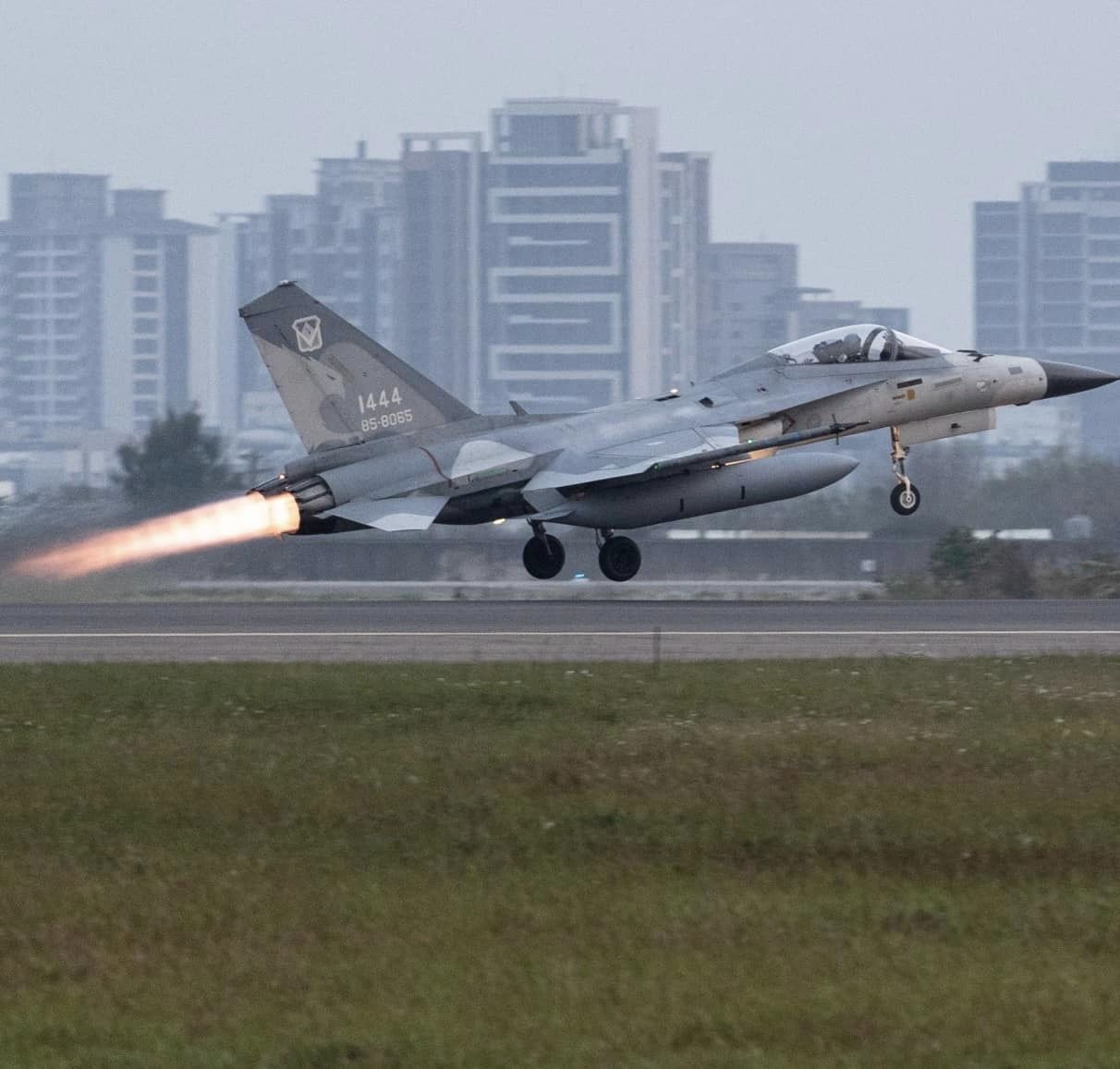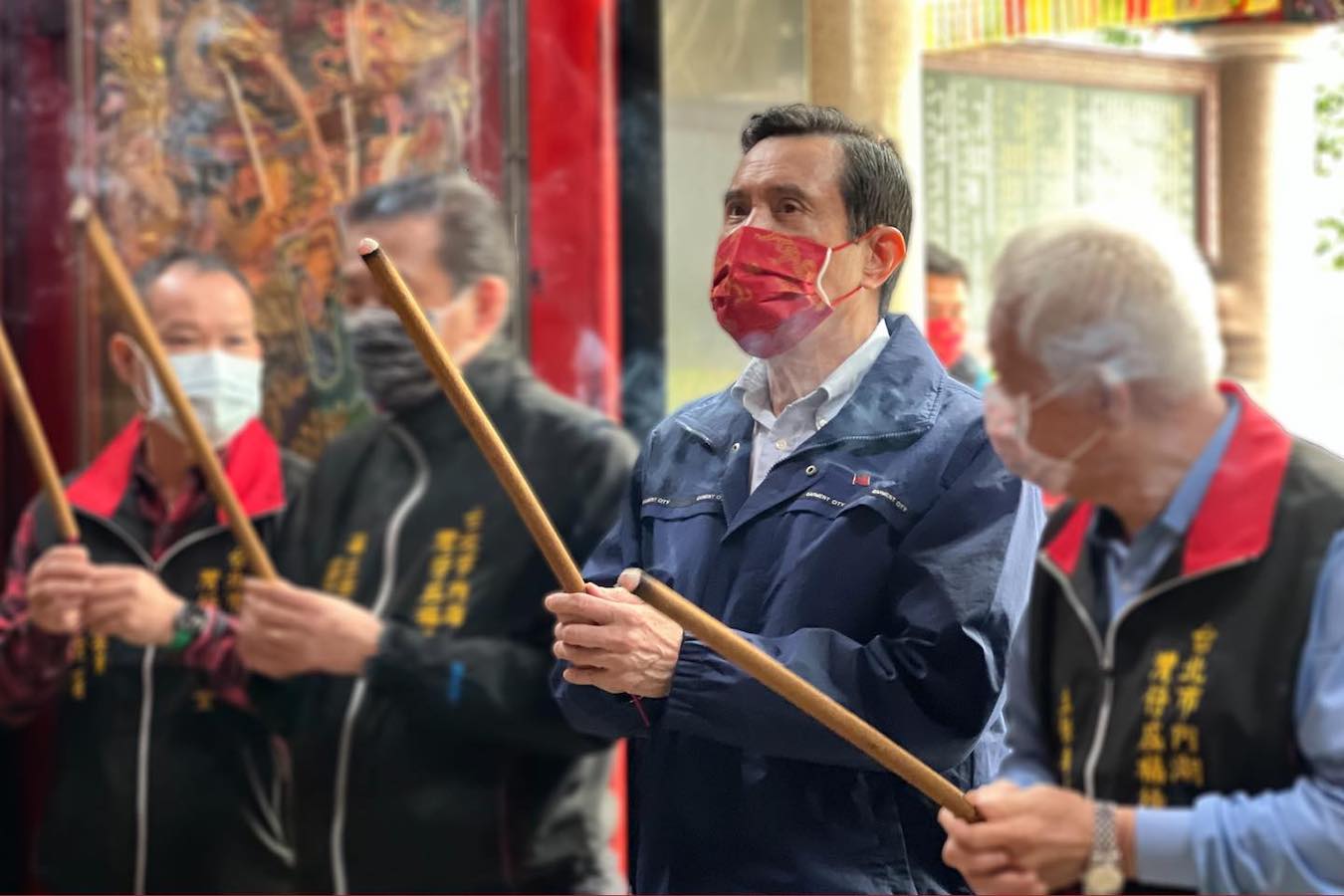by Brian Hioe
語言:
English
Photo Credit: 國防部發言人/Facebook
CHINA HAS ONCE again begun carrying out military exercises in response to a meeting between a Taiwanese president and a US Speaker of the House. In this case, on Saturday, China announced three days of military exercises following the meeting that took place between US Speaker of the House Kevin McCarthy and Tsai Ing-wen on Wednesday in California.
Footage of the exercises released by the Chinese government shows truck-mounted missile launch platforms, warships, and warplanes. This seems intended to signal China’s military capacities at present. Video responses by Taiwan’s Ministry of National Defense (MND), primarily showing members of the Taiwanese military observing Chinese exercises using drones, warplanes, and navy vessels, also are intended to signal Taiwan’s capacities. Videos released by the MND show that Taiwanese warplanes are equipped with missiles during operations, so as to suggest readiness to defend Taiwan in the event of warfare.
71 PLA aircraft and 9 vessels were detected by 16:00(UTC+8) on April 8th. 45 of the detected aircraft had crossed northern, central, and southern median line of the Taiwan Strait and entered our southwest ADIZ. pic.twitter.com/ADpTZaoR0B
— 國防部 Ministry of National Defense, R.O.C. 🇹🇼 (@MoNDefense) April 8, 2023
Verdicts on China’s spate of military activity have been mixed. Namely, some take the view that China’s actions are more restrained compared to the exercises that ensued after Nancy Pelosi’s visit to Taiwan in August of last year. The August live-fire exercises took place closer to Taiwan than during the Third Taiwan Straits Crisis. But by contrast, this time around the exercises take place closer to China’s coast of Fujian. Some questions have been raised about whether international media is sensationalizing the drills in a way that ultimately contributes to the rising of tensions.
Either way, on Saturday, April 8th, Taiwan’s MND detected 71 aircraft and 9 vessels by 4 PM. 42 aircraft and 8 vessels had been detected by 11 AM and 45 of the aircraft entered Taiwan’s Southeast Air Defense Identification Zone, referring to the airspace around a country in which planes normally identify themselves for security purposes. This involved crossing the northern, central, and southern median lines of the Taiwan Straits.
But regarding whether China is trying to register displeasure with the Tsai-McCarthy meeting in a manner that is more restrained than before, or whether this is simply more military bluster by China, certainly, it is probably premature to come to any verdict at present. It is possible that China will announce more exercises or the extension of the current exercises once three days is up, with sudden extensions or the announcement of new exercises also occurring last August.
Some have interpreted China’s actions as intended to simulate a blockade. Namely, China announced that it would be conducting inspections and searches of ships in the Taiwan Straits, which some interpret as a “soft blockade” or practice for a future blockade. Regardless, with increasing discussion of China’s August live-fire exercises as intended to simulate a blockade when there was previously discussion of Chinese military action mostly in terms of all-or-nothing invasion scenarios, China certainly hopes to come off as conducting a blockade.
 Taiwanese Tsai Ing-wen during her meeting with US Speaker of the House Kevin McCarthy. Photo credit: Tsai Ing-wen/Facebook
Taiwanese Tsai Ing-wen during her meeting with US Speaker of the House Kevin McCarthy. Photo credit: Tsai Ing-wen/Facebook
For example, the MND has denied claims by China that it escorted a ferry carrying 57 passengers between Taiwan’s outlying island of Matsu and Fujian, stating that Taiwanese vessels had instead escorted it. The MND has stated that China hopes to appear as though it is able to already operate unhindered in Taiwanese waters, including conducting escorts of Taiwanese vessels, but this is not the case.
To this extent, with China now responding each time to meetings between the US Speaker of the House and Taiwan’s president with military exercises, this sets a precedent for how China will respond in the future to such meetings. That being said, the past two decades show that China already responded with military exercises to stopovers by the Taiwanese president in the US on previous occasions.
However, one notes there was already an ongoing debate about whether the Pelosi visit benefitted Taiwan or not. After all, the visit proved a symbolic show of support for Taiwan, but there were not any concrete substantial outcomes such as a trade deal or arms agreement. The Pelosi visit may, in fact, have been more about US domestic politics with Pelosi hoping to shore up the Democrats’ credentials as tough on China through a show of support for Taiwan.
This conflict between the two views was the latest instantiation of a longer-running debate about symbolic shows of support for Taiwan that may provoke China yet accomplish little substantive, such as changing the name of Taiwan’s representative offices, and lower-key but more substantive support for Taiwan. Some argue that symbolic shows of support are important in terms of international diplomatic signaling and call China out on its bluffs, while others take the view that they accomplish little except unnecessarily put Taiwan in the crosshairs when Beijing seeks to register discontent through military exercises. Taiwan reportedly did not wish for McCarthy to visit in a way that triggered Chinese exercises, McCarthy having stated numerous times that he would like to visit, and so persuaded McCarthy to instead meet with Tsai in California after sharing intelligence with him.
 Photo credit: 國防部發言人/Facebook
Photo credit: 國防部發言人/Facebook
In this light, one expects there to be a renewed round of debate about symbolic versus substantive means of support for Taiwan after China’s recent exercises.
But, at the same time, it proves a question as to how China’s exercises will register in domestic political discourse. As with the live-fire exercises that followed the Pelosi visit, at least as of yet the news cycle has not become wholly preoccupied with the exercises, with celebrity gossip and election cycle news still predominant. It is to be seen whether the Taiwanese public has a stronger reaction to the current set of exercises than to the post-Pelosi live-fire drills, which Taiwanese society largely did not react to, seeing as the threats occurred at a remove from Taiwan. Taiwan has had decades of Chinese threats, with threats having long since become a repetitive news item.
Moreover, though the drills have just started, one notes that there is less coverage of the current drills than last year in August. This may be a product of the drills taking over Easter weekend for much of the western world, affecting western media organizations.
Yet the next year will be an election year and so one expects the drills to be leveraged on for campaigning by both the pan-Blue and pan-Green camp. The pan-Blue camp will allege that the drills show that the DPP is playing with fire in strengthening relations with the US, thus provoking China, and that Taiwan will only be safe with the KMT in power–its traditional claim as to why it should hold political power in Taiwan.
 Former president Ma Ying-jeou. Photo credit: Ma Ying-jeou/Facebook
Former president Ma Ying-jeou. Photo credit: Ma Ying-jeou/Facebook
By contrast, seeing as former president Ma Ying-jeou recently visited China for a trip that the pan-Blue camp has framed as part of efforts to lower tensions and the drills still happened anyway, the pan-Green camp will argue that the KMT only intends to sow doubt about potential allies and undercut Taiwan’s defense because of its pro-China agenda. That the drills still took place in spite of the KMT framing Ma’s actions as staving off war will be used to argue that this shows that the KMT cannot ward off Chinese aggression either, and so it is a better choice for Taiwanese voters to stick with the DPP–which will continue with efforts to consolidate relations with allies if it continues to hold power rather than blithely accommodate China.
In this sense, it is possible that the major outcome of China’s live-fire exercises is that it will accelerate the framing of next year’s elections about viable strategies for keeping Taiwan safe–whether that is conciliatory action towards China, per the KMT, or attempts to strengthen defense and ties with like-minded allies, per the DPP. The major issue of the 2024 presidential elections, in this sense, could be regarding Taiwan’s diplomatic strategy in the international sphere.

